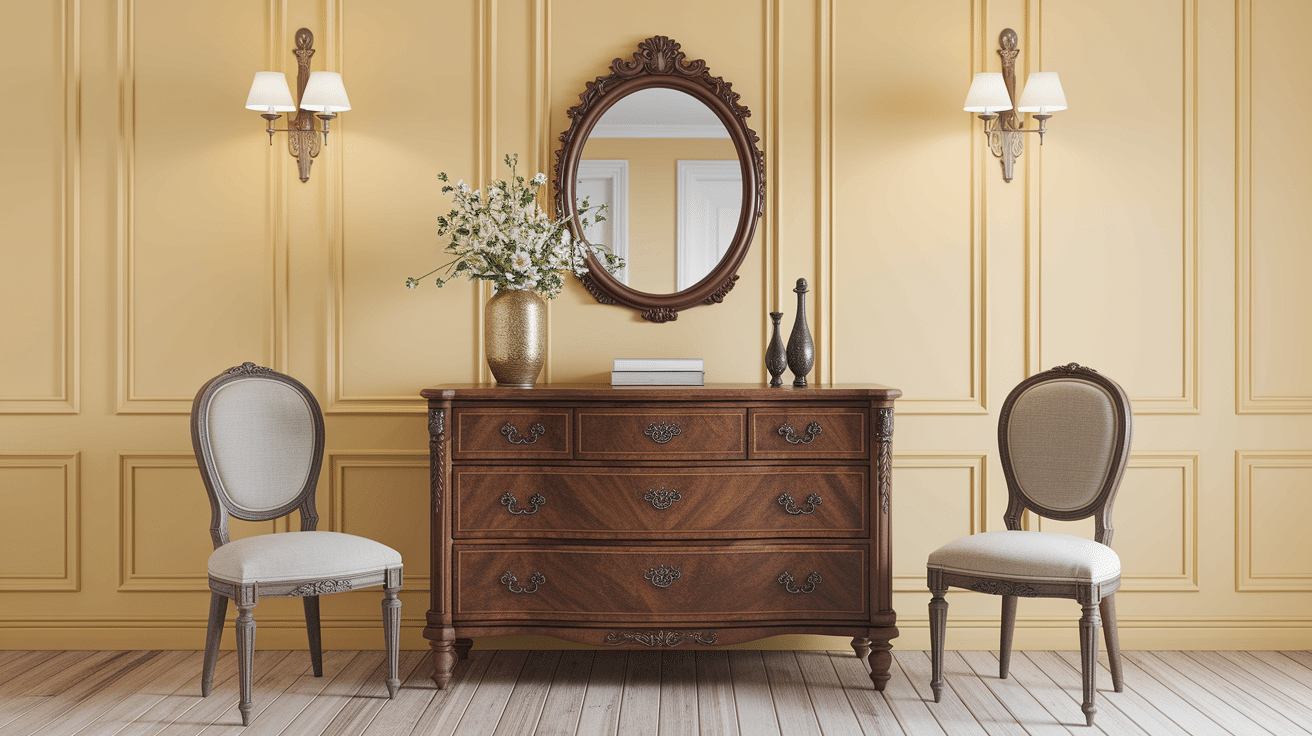Ever walked into a thrift store, spotted that perfect wooden dresser, and then caught a whiff of that old, musty smell? I’ve been there, too. Last month, I found a gorgeous oak cabinet for half its value, but the moment I brought it home, my entire living room smelled like my grandmother’s basement.
Wood furniture holds onto smells like memories – sometimes pleasant, sometimes not so much. That musty odor isn’t just unpleasant; it can make your whole home feel less fresh.
The good news is that you don’t need to live with that smell or pass up on beautiful wood pieces because of it. The right approach can remove those musty odors.
What if I told you that items already sitting in your kitchen could make that beautiful wooden chest smell as good as it looks?
What Causes Musty Smells in Wood Furniture?
Wood furniture can develop unpleasant smells over time. Understanding why this happens helps you tackle the problem more effectively.
Wood isn’t solid all the way through—it’s actually full of tiny holes. These small spaces act like sponges, soaking up moisture from the air and trapping odor particles deep within the wood grain.
Due to their structure, these holes store smells for long periods and allow scents to release slowly over time. This is why wooden items can smell musty for months or even years. Several things can create that classic “old furniture” smell:
- Mold and mildew growth: When wood stays damp, tiny fungi begin to grow. They give off that familiar musty scent.
- Trapped moisture: Water that soaks into wood and can’t dry properly creates a damp smell.
- Bacteria: These tiny organisms break down materials in the wood and leave behind smelly compounds.
- Long-term storage: Furniture kept in basements, attics, or storage units without good air flow tends to develop stronger musty smells.
- Age: Older pieces have had more time to collect and trap various odors from their surroundings.
The smell you notice is often a mix of all these factors working together, which is why a single quick fix doesn’t always solve the problem.
Immediate Fixes for Musty Furniture Smells
You don’t need to live with that musty smell while waiting for a long-term solution.
Start by completely cleaning the surface to remove dirt, dust, and possible mold. Mix equal parts white vinegar and water in a spray bottle. Lightly mist the wood (don’t soak it) and wipe it with a soft cloth. Vinegar kills most mold and bacteria that cause bad smells.
For finished wood, use a mild wood soap mixed with water. Dip a cloth in the solution, wring it well, and wipe all surfaces. For stubborn smells, try a mild anti-fungal cleaner that’s safe for wood. Always test in a hidden spot first.
After cleaning, wipe everything dry with a clean cloth. Move the furniture to a spot with good air flow to finish drying completely.
Once clean, try these simple household items to pull out lingering smells:
1. Place small bowls of white vinegar in drawers or cabinets for 24-48 hours. The vinegar absorbs odors rather than just masking them.
2. Activated charcoal is a great way to remove wood odors. Put some in small paper bags or bowls, and store them inside drawers or cabinets for several days.
3. Fresh coffee grounds not only absorb smells but also leave a pleasant scent behind. Place small open containers of grounds inside drawers.
4. Baking soda is another excellent odor absorber. Sprinkle it on surfaces or place open boxes inside furniture pieces for a few days.
Remember to replace these natural deodorizers every few days until the smell improves.
Time-Intensive Solutions for Deep Set Odors
When quick fixes aren’t enough, these more thorough methods can help remove stubborn smells that have settled deep into your wood furniture:
1. Sunlight and Air Circulation Treatment
Place furniture in direct sunlight with good airflow around all sides. The UV rays naturally kill mold while helping dry out trapped moisture. Adding fans increases air circulation and speeds up the drying process. This method works best on warm, low-humidity days and may take several days of repeated exposure.
2. Dehumidifying the Environment
If you live in a humid climate, run a dehumidifier near your furniture for several days. Aim to keep humidity levels below 50% to prevent new mold growth. This is especially helpful for furniture that will be kept in naturally damp areas like basements or near bathrooms.
3. Complete Disassembly
For extremely persistent smells, remove drawers, doors, and any detachable parts. This ensures all components get proper air exposure and treatment. It also allows you to clean hidden areas where moisture and mold might be lurking, such as drawer tracks and corner joints.
4. Surface Sanding
Sand surfaces lightly with fine-grit sandpaper (start with 120-grit, finish with 220-grit) in the direction of the wood grain. This removes the top layer where odors may be trapped deep in the wood pores. Be careful not to sand too aggressively on veneered furniture, as you might sand through the thin top layer.
5. Refinishing for Protection
After sanding and cleaning all dust thoroughly, apply a new coat of finish, sealer, or paint. This creates a barrier that not only locks out future odors but also prevents moisture from being absorbed into the wood again. Oil-based polyurethane works well for this purpose.
Natural and Diy Solutions for a Fresh Scent
After removing the musty smell, you can add pleasant natural scents to your wood furniture with these simple DIY methods:
- Cedar wood additions: Place cedar blocks or chips inside furniture. Cedar absorbs odors while giving off a clean, woody scent. Sand the cedar lightly every few months to refresh its scent.
- Lavender and baking soda mix: Combine 1 cup of baking soda with 5-10 drops of lavender essential oil. Place in small jars with holes in the lid or sprinkle directly in drawers and vacuum after 24 hours.
- Homemade potpourri sachets: Fill small fabric pouches with dried herbs and spices like rosemary, cloves, and cinnamon. These add subtle, natural fragrance while taking up minimal space.
- Citrus peel bundles: Dry orange, lemon, or lime peels and tie them in small bundles. The natural oils freshen the air and help deter wood-damaging insects.
- Vanilla extract cotton balls: Add a few drops of pure vanilla extract to cotton balls and place in corners. Replace weekly for a sweet, comforting scent that most find pleasant.
Conclusion
Getting rid of musty smells from wood furniture takes time, but it’s worth the effort. You might need to try a few different methods before finding what works best for your piece.
Start with a good cleaning, then move to odor absorbers like baking soda or activated charcoal. For tough cases, sunlight, fresh air, and maybe even sanding might be needed. Once the smell is gone, keep things fresh with natural scents like cedar or citrus.
Remember that older wood furniture often has character and history that new pieces don’t have. By removing that musty smell, you’re giving something special a second life.
Have you tried any of these methods? Which worked best for your furniture? The satisfaction of sitting next to a beautifully restored piece that smells as good as it looks is truly rewarding.
Frequently Asked Questions (FAQs)
What Neutralizes Musty Smell?
White vinegar, baking soda, activated charcoal, and coffee grounds all neutralize musty smells by absorbing odors rather than just covering them up.
What is a Homemade Musty Odor Eliminator?
A homemade musty odor eliminator is a DIY solution made from common household ingredients that removes stale, damp smells from your home without using harsh chemicals.
How Long Does it Take for Wood Smell to Go Away?
Wood smells typically take 1-3 weeks to disappear naturally. The time varies based on wood type, air flow, and room size. Odor removers can speed up this process.















One Comment
vavada: vavada casino – вавада